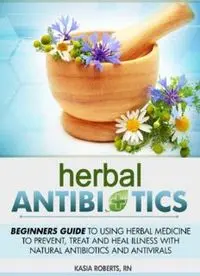
Herbal Antibiotics: Beginners Guide to Using Herbal Medicine to Prevent, Treat and Heal Illness with Natural Antibiotics and Antivirals PDF
Preview Herbal Antibiotics: Beginners Guide to Using Herbal Medicine to Prevent, Treat and Heal Illness with Natural Antibiotics and Antivirals
Copyright © 2014 Kasia Roberts, RN All right reserved. Disclaimer The information in this book is not to be used as medical advice and is not meant to treat or diagnose medical problems. The information presented should be used in combination with guidance from your physician. All rights reserved. No part of this publication or the information in it may be quoted from or reproduced in any form by means such as printing, scanning, photocopying or otherwise without prior written permission of the copyright holder. Disclaimer and Terms of Use: Effort has been made to ensure that the information in this book is accurate and complete, however, the author and the publisher do not warrant the accuracy of the information, text and graphics contained within the book due to the rapidly changing nature of science, research, known and unknown facts and internet. The Author and the publisher do not hold any responsibility for errors, omissions or contrary interpretation of the subject matter herein. This book is presented solely for motivational and informational purposes only. Introduction The field of herbal antibiotics offers a different sort of ancient world: one that brings a return to old practices, old ideas. Herbal antibiotics offer understanding about the undeniable strength of the plant kingdom. As the forests fizzle and humanity takes to the city streets, knowledge about this plant kingdom fades. Pharmaceutical medicine is found in every cabinet across the world, and miraculous drugs are working to fight undying battles against bacterial infections, against colds, and against serious diseases. However, as scientists develop new synthetic drugs, the bacteria are growing stronger. They’re evolving faster than ever. And this evolution and change are creating the disastrous antibiotic crisis. The antibiotic crisis forces society to turn back to what it once knew: herbal antibiotics, in order to avoid the limitations of the synthetic antibiotics. With herbal antibiotic knowledge, we hold the ability to live optimally. We can eat well to boost our immune system; we can become proactive in our herb picking and utilization. Herbal medicine is empowering because it’s about how to live for optimum health. If we begin to understand that there are active healing and immune-boosting compounds in all the vegetables, leaves and herbs that we eat and that the largest part of the equation is keeping our immune system healthy, then we are choosing to be proactive. We don’t need to wait until we’re ill to think about the subject of healing. Herbal medicine can be there as part of our everyday lives. Should an infection take hold, however, we can then turn to the more potent forms of herbal antibiotics, as outlined in this book. Herbal antibiotics are bursting with antibacterial, antiviral, and immune system-boosting properties. Each herb outlined in this book maintains a complex structure, one that can beat back against bacteria in a different sort of way than the average synthetic antibiotic. The herbs come from the earth. They’ve been there, assisting countless generations with their health decisions in past centuries. The rediscovery of these herbs can truly turn the clock back against the antibiotic crisis and create a better, more rounded world: one that turns to the synthetic antibiotics when they are absolutely required, and one that turns to the natural world to seek interior strength and vitality. Table of Contents Introduction Chapter 1: The Reality of Antibiotics THE PURPOSE OF ANTIBIOTICS HOW DO ANTIBIOTICS WORK? THE CURRENT SYNTHETIC ANTIBIOTIC CRISIS SYNTHETIC ANTIBIOTIC SIDE EFFECTS Chapter 2: Herbal Antibiotics: History and Utilization PRODUCTION AND PROFITS HERBAL ANTIBIOTIC HISTORY Chapter 3: Immune-System Strengthening Herbs GINSENG GINGER TURMERIC GANODERMA CAT’S CLAW GINKGO BILOBA ROSEMARY Chapter 4: Antiviral Herbs ST. JOHN’S WORT LICORICE ROOT ELDERBERRY ECHINACEA GARLIC Chapter 5: Antibiotic Herbs CRANBERRY TEA TREE ARTEMISIA USNEA OREGANO MINT CULINARY SPICES Conclusion Chapter 1: The Reality of Antibiotics
